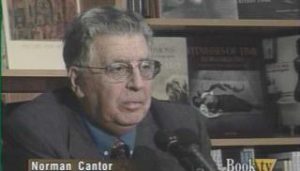The Sacred Chain: The History of the Jews
 The Sacred Chain by Norman F. Cantor (pictured). HarperCollins Publishers (New York, 1994).
The Sacred Chain by Norman F. Cantor (pictured). HarperCollins Publishers (New York, 1994).
reviewed by Dr. William L. Pierce
“ANTI-SEMITES sensed the truth of Jewish history, the specialness of the Jews, their strangeness on the face of the earth. The anti-Semites could not stand to witness all the good things the Jews had brought mankind because that would remind these inferior people of their own underdevelopment and depravity.” (p. 11) These two sentences sum up the 472 pages of Norman Cantor’s book, its hubris and subjectivity. Yes, most everything you’ve heard about the Jews is true, but only a warped, envious, hate-filled person would object to the contributions of God’s Chosen People to the benighted Gentiles.
The Sacred Chain is a survey of the history of the Jews from their obscure origins as just one of many Semitic tribes inhabiting the eastern Mediterranean to their unique position of international wealth and power today. Although Cantor is an academic, this is not an academic history, for there are no footnotes citing sources. There are a bibliography and a useful index, however, and the preface suggests that the book would be suitable for an introductory college course.
One of the themes of Cantor’s book is that the Jews are indeed a separate race and not just a religious or cultural group. They are a race created, in part, by their religion and modified by their contact with other peoples, but nevertheless a race with their own peculiar mentality, which has endured for many centuries.
Another of Cantor’s themes, as can be gleaned from the opening quote, is the “superhuman strength, intelligence, and durability” of the Jews. (p. 11) While the author’s overweening pride of race may be difficult at times for the Gentile reader to stomach, it is itself instructive. More important, this arrogance and presumptuousness result in candor when the author discusses the more negative aspects of Jewish history.
A third motif of Jewish history chronicled in the book is the cyclical ups and downs in the fortunes of the race. Gamblers and speculators by nature, the Jews live close to the edge, pressing their luck, at times riding high on a winning streak, and at other times seeing their power and wealth come crashing down.
There is only enough space in a short review to cite a few of the many revelations and confirmations of misdeeds contained in this volume. The following will give the reader a brief sampling.
One charge made against the Jews has been their involvement throughout history in the slave trade. In the Carolingian Empire “Jewish merchants exported to the Mediterranean world not only fur, timber, and swords, but also slaves. Blond Germanic slaves brought to the markets and Arab Mediterranean cities by Jewish merchants were much in demand, especially if they were young boys or adolescent, nubile women.” (p. 162) Cantor goes on to explain that by 1000 AD Jews were well established in the “towns along the Rhine, which they used as a conduit to trade in the Low Countries, northern Germany, and Scandinavia. The size and prosperity of the slave trade with the Mediterranean increased.” (p. 163) How were the Jews allowed to engage in the trafficking of White slaves to Arab lands through the heart of Europe? Basically it came down to using their great wealth to buy “the goodwill of the magnates.” (p. 166)
But such an outrage could not be endured forever. In 1096, at the beginning of the First Crusade, Christian knights on their way to the Holy Land “inflicted terrible pogroms upon the Rhenish Jews . . . . It was a rupture with several centuries of Jewish peace, prosperity, and privilege . . . .” (p.167) Thus, we see an instance of the Jews waxing prosperous for a time, overreaching themselves, and suffering the consequences.
As all good gamblers do, the Jews try to hedge their bets by wagering on more than one horse. Thus, if we move ahead 800 years we find that “empirical data support the contention of French and German anti-Semites in the 1920s and 1930s that Jews were both capitalists and communists.” (p. 274) Yes, it is true: “Unfortunately, there were circumstantial and anecdotal, even some statistical, verifications for the popular anti-Semitic double-faced image of the Jews around 1930 as both slippery entrepreneurs and conspiratorial communists.” (p. 335)
The author divulges other interesting facts: Organized crime in America originated in illegal Jewish enterprises around the turn of the century. “It was the Jews, by and large, not Italians, who created what was called the Mafia. In the 1920s the Italians began to replace the Jews in New York organized crime industry, but as late as 1940 if you wanted a spectacular hit you were looking for a representative of the Lepke Buchalter Gang, also known as Murder Inc. Jews also were also [sic] prominent in the gambling trade and developed Las Vegas in the 1940s. It was a Jewish gambler who fixed the 1919 baseball World Series — what became known as the Black Sox scandal.” (p. 387)
Continuing through Jewish history to the late twentieth century we come to the ascendancy of the Zionist state. Is Israel a parasite nation as some have charged? “The fact is that the Jewish economy in Israel from the first decade of the century to today has never been a viable one. The Jews in Zion have never been able to support themselves.” (p. 369) So how have the Israelis managed to build both a modern welfare state and a mighty military machine? Since 1970 the Jewish state has “become thoroughly dependent on American government aid for both military and civilian purposes — at least five billion dollars a year. When it is factored in that Jewish charitable sources abroad provide annually a similar sum, Israel has to be recognized as . . . greedily and recklessly used to living off other peoples’ money.” (p.385)
Although there are many more exposés in The Sacred Chain, Cantor is not a renegade Jew, and the book is certainly not a hostile critique of Jewry. Cantor is intensely proud of his people, warts and all, and if Jews have been highly successful slavers, subversives, gangsters, and mendicants it is simply that the Jews are a genetically superior people who will excel at any endeavor they choose to undertake.
The problematic issue of the future of the Jews is dealt with in a speculative concluding chapter. One thing is certain: even by the standards of their roller-coaster past “nothing in Jewish history equaled this [present] degree of Jewish accession to power, wealth, and prominence.” (p. 406) The Jews are at the pinnacle; are they about to fall? No, not in the traditional sense of being brought low by an angry host population. Yet “it appears from present perspective that the history of the Jews as we have known it and them is probably approaching the end.” (p.425) The agent of Jewish destruction is demographics, since “fifty-two percent of Jewish marriages in 1990 were intermarriages with Gentiles.” Intermarriage and a low birthrate “signal the approaching end of Jewish history as we have known it.” (p. 426)
In an apocalyptic version of the end of history, Cantor declares that the end is near because “the Jews have fulfilled their role in history. They have been a light to the world. . . . The Jews served their own purpose, and God’s purpose, and mankind’s purpose. . . . For three thousand years this special people lived and propagated and imparted their unique ideas to mankind. . . . Now the Jews’ innate superior qualities will be perpetuated by intermarriage through the bloodlines of millions of people and diffused through American, Arab, and other societies.” (p. 434)
So not to worry. Even after the Jewish race, as such, has all but disappeared Jewry will continue to exert a powerful influence through a sort of genetic half-life as a hybrid international elite of the New World Order: “The Jews are a superior people intellectually, and as long as Jewish genes exist, the extraordinary impact Jews have had in twentieth century thought will continue indefinitely.” (p. 423) In case the reader did not grasp the full significance of this statement, the author reiterates: “The genetic intellectual superiority of the Jews will be extended and as long as its carriers are individually free and privileged to pursue their interests in science, philosophy, literature, and the arts, highly advantageous consequences for humanity will follow.” (p. 425)
Whew! Is there any way to opt out from this unending flow of blessings?
* * *
Source: National Alliance





